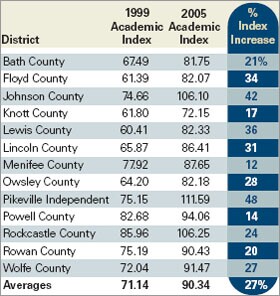Corrected: An earlier version of this story misidentified the river that flows alongside the town of Clinton, Tenn.
Taking a job as a mathematics or science teacher in rural Kentucky or Tennessee is an appealing career choice for educators who grew up in those communities. It’s stable work, which means a lot in farming and mining towns where jobs are scarce. It pays well, in an area where the cost of living is cheap. And it allows some young educators to work in the same schools where their parents and grandparents once taught.
But persuading math and science teachers from big cities and suburbs to move to isolated communities lacking in cultural amenities is a much tougher sell.
“We’re small,” said Kristal Harne, an elementary school math and science teacher from Liberty, Ky., population 1,897. “We don’t even have a Wal-Mart.”

Advocates for rural education today are seeking to cultivate and sustain their schools’ workforce by following a strategy they believe is tailored to the needs of small, often insular communities. With federal aid, several university and school leaders have focused on training math and science teachers in new classroom techniques and content, then having them return to their rural districts to provide support to their colleagues.
Those efforts, which date back more than a decade, have shown positive results in rural districts, according to a recent report .
That teacher-to-teacher connection, supporters of such programs say, provides educators working in rural, often impoverished districts with steady, on-site help in the subjects that vex many of them the most.
NSF Support
Ms. Harne was one of 35 primary and secondary teachers from Kentucky, Tennessee, and Virginia who attended a workshop hosted here June 25-29 by the Appalachian Math Science Partnership, which seeks to develop those teacher-leaders.
“There are simply too many math and science teachers who need assistance of one kind or another, and too few people in higher education to help them meet their needs,” said Ron Atwood, an administrator who helps oversee the Appalachian project. When it comes to finding qualified math and science teachers, he said, “more and more, we’re trying to grow our own.”
The Appalachian project is one of several rural education ventures launched in the mid-1990s with support from the National Science Foundation, which devoted more than $100 million to them over the next decade. Some projects continue to receive NSF support today, including the Appalachian partnership, which works with 51 districts across the region.
Officials working on those projects issued a report last month showing improved test scores in districts that sent teachers through the training, gains supporters believe are partly attributable to math and science instruction that rural teachers are passing on to their colleagues.
Different Student Needs
Ms. Harne and three colleagues drove three hours from the 2,400-student Casey County school district, in south-central Kentucky, to attend the week of workshops. The teachers gathered at a vocational center in Clinton, a small town hugging the Clinch River, just up the highway from the renowned federal scientific laboratories at Oak Ridge.
The workshops, led by K-12 and university educators, focused primarily on “formative assessment”—in-class tests and exercises that tell teachers whether students are grasping material and allow them to adjust their lessons in midstream; and “differentiated instruction”—crafting lessons to meet the needs of students with different abilities.
Strong teaching is one of the most important factors in improving student achievement in math and science, researchers say. But recruiting and retaining teachers in those subjects is difficult.

Recent research has shown that turnover among math and science teachers is about the same as it is for other teachers, said Richard M. Ingersoll, a professor of education and sociology at the University of Pennsylvania, who has studied those trends. But schools are not able to recruit enough math and science teachers to keep up with the numbers abandoning the field each year, he said. High school officials report that math teaching vacancies are the hardest to fill among all academic-content areas, and that physical- and life-science jobs are not far behind.
Sustained induction programs have proved effective in retaining teachers, studies have shown. But those programs are not widely available.
New math and science teachers, especially those at early grade levels, are likely to enter the profession with a shaky grasp of those subjects and may be reluctant to approach colleagues for help.
“If you ask people, what was [their] best subject when they got their teaching degree, they don’t say it was math,” said Sandra L. Godbey, a curriculum coach in Casey County. As a result, even when they try to teach elementary-level math, Ms. Godbey said, “they don’t understand the appropriate vocabulary, or the ‘why’ of the math. They just know the algorithm.”
Workshop organizers believe teachers, rather than university professors or outside consultants, are more likely to connect with educators in their home districts.
“Teachers have more credibility than higher ed folks,” said Mr. Atwood of the Appalachian partnership. “They’ve been in the trenches.”
In one session, the teachers took part in a lesson on how to use formative assessment during an elementary science laboratory activity. Teachers were asked to test the force of a magnet resting atop a small, thin piece of wood, and measure how much weight it would hold and record the results on a graph.
Kathy L. Strunk, one of the regional coordinators for the Appalachian program who led the session, asked the teachers to think of ways to gauge individual students’ prior knowledge of the concept, as well as their grasp of the new material. Teachers can ask students questions orally or in writing, during or after the experiment, she suggested. Their answers can help teachers determine which areas of magnetism students understand the least.
“As you’re observing kids doing these things, you’ve got to make up your mind: What kinds of things are you looking for?” Ms. Strunk said. “It’s hard to assess on the fly. You have to have a target goal in mind.”
Big Ideas, Small Groups
In a later session, Ramona C. Jayner, an assistant principal in the 2,200-student Corbin, Ky., district, discussed the potential for using differentiated instruction.
Working with students of vastly different abilities can make in-class science experiments difficult, because stronger students tend to take over the project, she noted. But teachers can put students in small groups where they will be challenged individually.
Ms. Jayner took teachers through a typical exercise that can help them gauge students’ knowledge of a subject and their overall ability levels. The teachers, acting as students, were asked the cost of driving to a particular location, given a number of factors, such as distance, a car’s mileage, and the price of gas.
Several Kentucky districts that took part in a rural teacher-training program saw their elementary scores increase. Similar efforts continue in most of those districts.

SOURCE: “A Legacy of Leadership and Lessons Learned,” Edvantia, 2007
Teachers should watch how students work in small groups, Ms. Jayner said. Who is leading the activities? Who is falling behind? When some teachers ask questions and offer suggestions for improving the gas-mileage lesson, Mr. Atwood, who is helping the instructors, asks them to approach this particular exercise differently.
“You’re thinking about your [own] students, and that’s good,” Mr. Atwood said. “But you should also think about yourself as a trainer, as a teacher. Think about yourself in two roles. You’re going to be leading these activities in the fall.”
Teachers can also use differentiated instruction with science lessons such as Newton’s laws of motion, Ms. Jayner said, spending more time with the struggling students on basic facts, while assigning advanced groups more difficult tasks and projects.
Differentiated instruction can make classes more manageable, Ms. Jayner explained. But teachers also need to avoid becoming too rigid in assigning students to groups. Students need to know that if they show progress, they will be given more-challenging assignments, she said.
Bridgett Hastings, a middle school math teacher from the 3,600-student Clay County, Ky., district, came to the workshop to learn more about differentiated instruction, and said it has the potential to work in her classes. But experience also has taught her that it is likely to draw some resistance from parents, who would question why their child is being given assignments different from some classmates’.
“Kids will say, ‘I want to do what he’s doing,’ ” said Ms. Hastings, now in her 15th year of teaching.
Ms. Harne believes she can help teachers in her district cope with those challenges. She was expected to present information on math content and formative assessment to elementary teachers in Casey County throughout the coming school year.
Tutoring a colleague whose math and science skills are shaky brings its own challenges, she acknowledged. “You want to be careful how you approach people,” she said, “because you have to work with them.”
But teachers in her district have been open to ideas that improve instruction, she added. “Teachers recognize it as a need,” Ms. Harne said of training in math content. “They know we’re there to be supportive. I think we’ll be received positively.”




